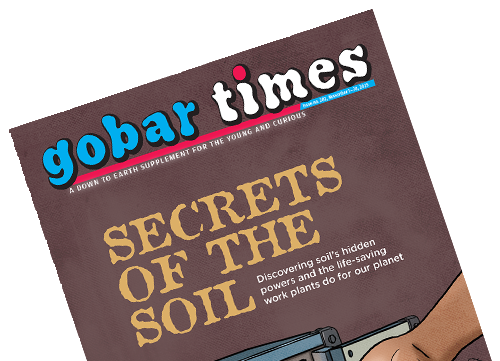
A vow from an environmentalist to pledge his duty to preserve Mother Earth. *********************************************** If I was the editor of Gobar Times, I would appreciate and highlight all those people in my magazine who try to keep our environment clean. This would include people who save and plant trees and conduct public programmes to spread awareness about environmental issues...

Recently, the mercury in many parts of northern India touched 48°C. Many records were broken by the rising temperature—March this year was marked as the hottest in the past 122 years! Public places, as a result, wore a deserted look as residents were forced to stay indoors.

A passionate movie buff and avid videographer narrates his journey through the reels on the importance of films in spreading environmental awareness. **************************** Growing up in Perumannur, a small village in Kerala, my childhood was all about ploughing fields, playful cows and calves, and a big pond where I learnt swimming. I was so close to nature that it never occurred to me if the environment—with all its greenery, birds, trees, and grass—can ever be distinctively separate from us. My training, among the lush green coconut and rice fields...

An incredible list of some must-watch environment movies and series—a perfect visual treat for your summer vacations! ********************************************** THE LORAX: In a treeless world, a 12-year-old boy is looking to impress a girl by searching for a tree. But, for that, he is required to know the story of Lorax, a charming creature. OKJA: The fight of young Mija to rescue Okja, a massive animal and...

A resolution by Leaders to save humanity from drowning in ‘Plastic’. ******************************************* On March 2, 2022, representatives from over 200 countries gathered in Nairobi, Kenya for the continued fifth session of the United Nations Environment Assembly. The assembly then created history when 175 countries unanimously agreed on a United Nations framework to fight global plastic pollution from cradle to grave...

India’s total forest cover is 21.71 per cent of its total geographical area and the target is to reach 33 per cent. The Forest Survey of India defines ‘forest cover’ as all land with minimum one hectare of tree patches and canopy density above 10 per cent... Read more.

How often does an older relative strike a conversation with you that begins with ‘back in our days...’? And how often do you switch off after hearing this apparently insipid conversation starter? If you do it often, then hang on! We have some news for you. These stories of the past from your elders, particularly about the environment, can provide a lot of crucial information and insights to you…

You know Jackie Chan, right? Or was he a superstar when I was growing up? Yes, you are right, you probably do not know Jackie Chan, the greatest martial artist to have ever walked the earth. The world changes fast these days. Heroes of my childhood are not the heroes of your childhood. Jackie Chan was a household name in urban India when I was growing up. He was an action hero who did all of his stunts himself. Yes, that’s right, no stunt double, no CGI (Computer-Generated Imagery), nothing, and he got hurt, really hurt, while performing his stunts, but he just went on and on like a trooper...

Climate change is no longer a discussion that can happen in silos. Increasing carbon footprint and its impact on the 21st century environment is becoming part of many daily conversations in schools. But to achieve long term goals, more needs to be done. India has the lowest per capita emissions compared to the major world economies including the US, China and the European Union. Despite this fact, the impact of climate change has become evident in our country through rising levels of air pollution and extreme weather situations. Therefore, India is an active stakeholder in shouldering the responsibility with its global …

Held as usual a few days before COP (October 28-31 last year), this youth conference is the biggest so far, with thousands of participants having registered from over 140 countries. This is leaps and bounds ahead of the few hundred participants that would attend the conference a decade ago. The sixth edition of the conference, for instance, held in Cancun, Mexico in 2010, saw just 500-odd attendees. The main agenda of the youth conference this year, as per Heeta Lakhani...

